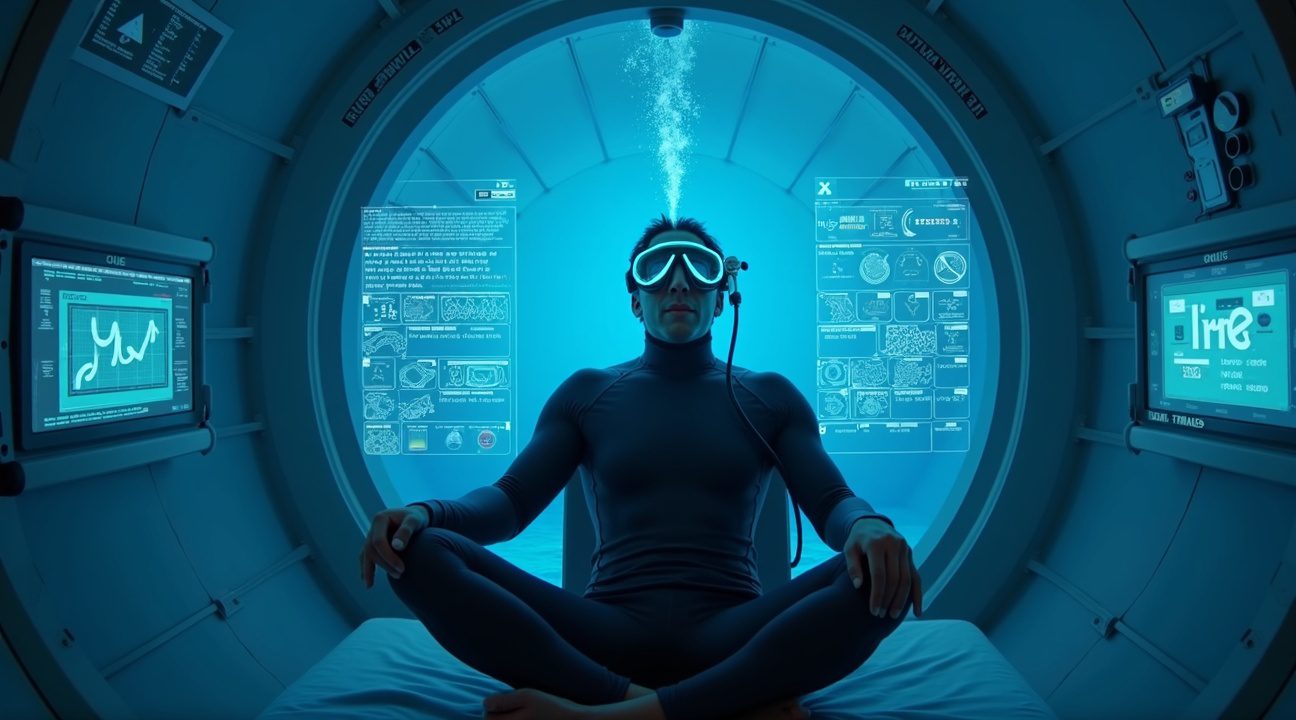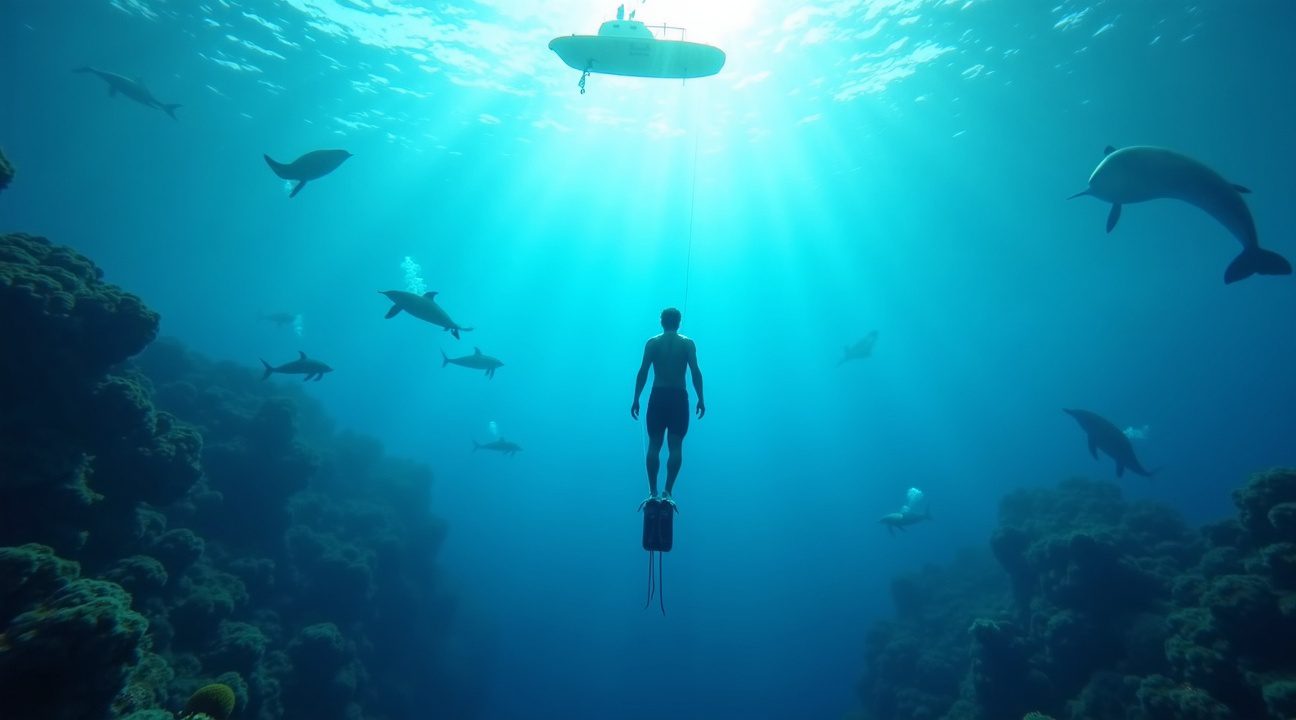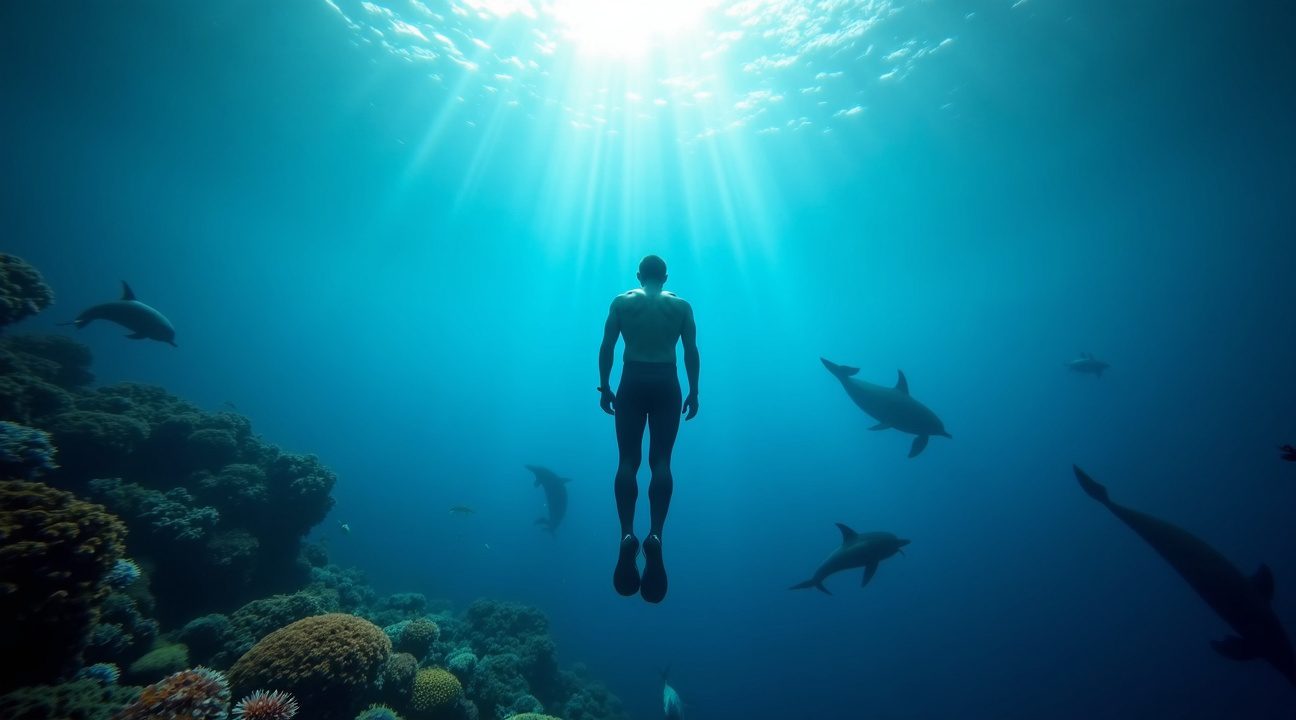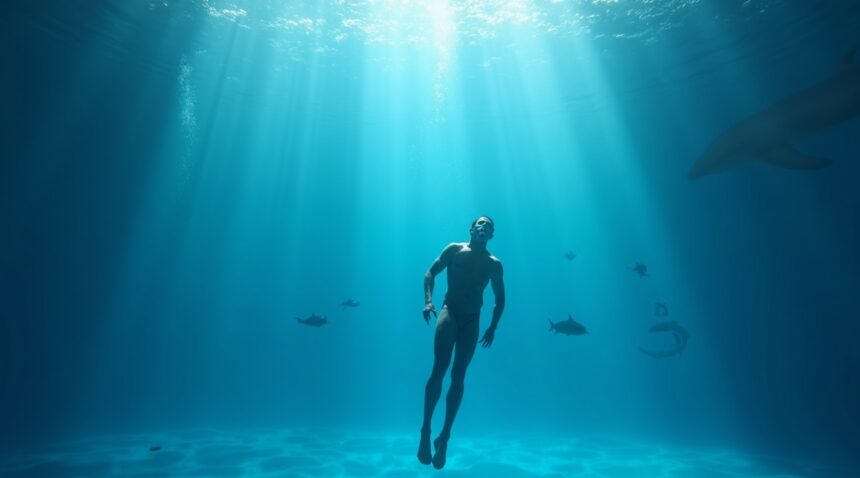Croatian freediver Vitomir Maričić achieved an extraordinary feat by holding his breath underwater for 29 minutes and 3 seconds, shattering the previous world record by nearly five minutes and surpassing the breath-holding capabilities of most marine mammals including dolphins.
Key Takeaways
- Maričić’s 29-minute breath-hold nearly doubles the typical 15-minute capacity of bottlenose dolphins and closely matches the 30-minute abilities of harbor seals.
- The achievement involved 10 minutes of pure oxygen pre-breathing, increasing blood oxygen saturation to five times the level achieved through normal air breathing.
- Marine mammals like Cuvier’s beaked whales remain unmatched, with breath-holding capacities exceeding 2 hours due to evolutionary adaptations over millions of years.
- The record served a dual purpose, raising awareness and funds for ocean conservation in partnership with Sea Shepherd.
- Human breath-holders depend entirely on training and mental discipline, lacking the anatomical advantages that give marine mammals the upper edge.
Maričić’s record represents more than just an athletic accomplishment. His performance showcases how humans can push biological boundaries through dedicated preparation and advanced techniques. The Croatian freediver spent years developing his lung capacity and mental control, proving that proper training can help humans compete with nature’s most efficient breath-holders.
The Science Behind the Record
The technical preparation for this record involved precise oxygen saturation protocols. Maričić inhaled pure oxygen for exactly 10 minutes before the attempt, flooding his bloodstream with oxygen concentrations far beyond what normal atmospheric air allows. This method helps the body maximize oxygen reserves prior to the dive, providing a crucial advantage over standard breath-holding approaches.
How Humans Compare to Marine Mammals
Despite Maričić’s remarkable performance, marine mammals still hold a distinct edge through evolutionary adaptations. Harbor seals, for instance, routinely dive for 30 minutes, and Cuvier’s beaked whales are known to remain submerged for over two hours. These animals have developed specialized traits such as enlarged hearts, higher blood volume, and unique muscle chemistry that allow for more efficient oxygen storage and use.
Conservation Advocacy Through Sport
The record attempt was more than a physical feat—it served as a platform for environmental awareness. Maričić collaborated with Sea Shepherd, a prominent ocean conservation organization, to bring global attention to marine protection. By linking extreme freediving to advocacy, this event reached audiences far beyond the sport’s usual followers, promoting vital conservation messages.
The Training Process
Training for a 29-minute breath-hold involves a combination of physiological and psychological conditioning. Freedivers increase lung capacity through targeted breathing exercises and bolster their underwater endurance in controlled sessions. Equally important is mental training—learning to relax, reduce oxygen consumption, and avoid panic under pressure.
Physiological Adaptations During Long Breath-Holds
During extended breath-holding, the body undergoes changes similar to those seen in marine mammals. Heart rate slows, blood flow is redirected from extremities to vital organs, and the body activates a conservation mode that prioritizes oxygen efficiency. Though not as developed as those in aquatic animals, these responses allow trained individuals to endure significant breath-hold durations.
Safety and the Evolution of the Sport
Maričić’s success underscores the importance of safety in extreme freediving. Record attempts require professional oversight, including medical supervision, emergency response readiness, and strictly monitored conditions to avoid life-threatening risks. The sport continues to evolve, with a deeper understanding of human limits and improved safety protocols allowing athletes to pursue more ambitious goals responsibly.
The Future of Breath-Holding Records
Advancements in training and technique may soon push breath-holding records even closer to marine mammal limits. Vitomir Maričić’s achievement sets a new benchmark that will undoubtedly inspire future freedivers to aim higher, not just in pursuit of personal or athletic milestones but also in championing efforts to protect the world’s oceans.
Croatian Freediver Holds Breath for 29 Minutes and 3 Seconds, Shattering Previous Record
Vitomir Maričić achieved what most people would consider impossible on June 14, 2025, when he held his breath underwater for an astounding 29 minutes and 3 seconds in Opatija, Croatia. This extraordinary feat shattered the previous world record by nearly five minutes, demonstrating the remarkable potential of human physiology when pushed to its absolute limits.
Official AIDA freediving judges verified Maričić’s attempt, and Guinness World Records has recognized it as the longest time breath held voluntarily underwater by a male. The Croatian freediver’s accomplishment represents a quantum leap in human underwater endurance, surpassing the previous oxygen-assisted record of 24 minutes held by Aleix Segura Vendrell.
Breaking Barriers for Ocean Conservation
Maričić’s record attempt served a dual purpose beyond personal achievement. He undertook this challenge to draw global attention to ocean conservation, using his platform to highlight the critical environmental issues facing marine ecosystems worldwide. This approach mirrors the intelligence and adaptability found in marine life, much like octopus species that demonstrate remarkable problem-solving abilities.
The freediver’s achievement puts human breath-holding capacity in perspective when compared to marine mammals. His 29-minute record actually exceeds the breath-holding capabilities of many whales and dolphins, though it still falls short of species like the Cuvier’s beaked whale, which can hold its breath for over two hours. Recent discoveries continue to reveal the extraordinary adaptations of deep-sea creatures, including fish found at depths of 8,300 meters, showcasing nature’s incredible ability to thrive in extreme conditions.
Maričić’s preparation for this record involved years of training his body to efficiently use oxygen and tolerate extreme carbon dioxide levels. Professional freedivers develop enhanced lung capacity, slower heart rates, and improved oxygen circulation through rigorous conditioning. The achievement also demonstrates how humans can adapt their physiology through training, similar to how scientists have observed innovative escape mechanisms in various research contexts.
The Croatian’s record represents more than just a number – it’s a testament to human determination and the urgent need for ocean protection. His success opens new discussions about human potential while serving as a powerful reminder of our connection to the marine environment he’s working to preserve.
How Pure Oxygen Pre-Breathing Enabled This Extraordinary Feat
The Science Behind Oxygen Saturation
Before Maričić’s record-breaking attempt, he spent 10 minutes breathing pure oxygen to flood his system with this life-sustaining gas. This pre-breathing technique doesn’t just fill the lungs—it saturates blood plasma with oxygen levels far beyond what normal air can provide. During regular breathing, humans typically absorb only about 21% oxygen from atmospheric air. Pure oxygen breathing pushes oxygen concentration in the bloodstream to nearly five times normal levels, creating a massive reserve that the body can draw upon during the breath-hold.
The process works by replacing nitrogen in the blood with oxygen molecules. Since nitrogen serves no metabolic purpose during breath-holding, eliminating it maximizes the available oxygen storage capacity. This technique essentially transforms the cardiovascular system into a high-capacity oxygen tank, similar to how deep-sea fish have evolved specialized blood chemistry for extreme environments.
Mental Control and Metabolic Management
Maričić’s success depended heavily on his ability to control his metabolic rate through extreme mental discipline. He described the first five minutes as “relaxation and pleasure,” a crucial phase where his body settled into an ultra-low energy state. This initial period sets the foundation for the entire attempt—any stress or elevated heart rate during these early moments can doom the record attempt before it truly begins.
The progressive stages he experienced reveal the body’s natural responses to oxygen depletion. Each phase requires different mental strategies and physical adaptations:
- Stage 1 (0–5 minutes): Deep relaxation and mental preparation
- Stage 2 (5–15 minutes): Maintaining calm as carbon dioxide begins accumulating
- Stage 3 (15–25 minutes): Fighting the body’s urgent signals to breathe
- Stage 4 (25–29 minutes): Operating on minimal oxygen reserves while resisting panic
Unlike marine mammals such as whales and seals, humans lack the physiological advantages that make extended breath-holding natural. Marine mammals can replace up to 90% of their lung air with each breath, while humans only manage about 20%. This efficiency gap means humans must rely entirely on conditioning, mental control, and techniques like oxygen pre-breathing to achieve remarkable feats.
The stark difference between human and marine mammal physiology becomes apparent when considering that intelligent marine creatures have evolved sophisticated oxygen management systems over millions of years. Humans compensate for these limitations through technology and training techniques that push the boundaries of what’s physiologically possible.
Maričić’s achievement demonstrates how human ingenuity can overcome biological constraints. The pure oxygen pre-breathing technique essentially gives humans a temporary upgrade to their oxygen-carrying capacity, allowing them to compete with nature’s most accomplished breath-holders. However, this feat requires extraordinary mental fortitude—something that can’t be replicated by simply following the technical steps.
The record also highlights the importance of understanding one’s physical limits while simultaneously pushing beyond them. The controlled environment and medical supervision during such attempts ensure safety while allowing for maximum performance. This balance between risk and achievement mirrors how advanced technology often pushes boundaries in unexpected ways.
Each stage of Maričić’s breath-hold required different coping mechanisms, from the initial relaxation phase through the final moments where every second demanded tremendous willpower. The technique he employed—combining oxygen saturation with mental control—represents the current pinnacle of human breath-holding capability, achieved through preparation, practice, and an understanding of both human physiology and its limitations.

Human Achievement Nearly Doubles Dolphin Capabilities While Approaching Seal Territory
This extraordinary accomplishment puts human breath-holding ability into perspective against both our everyday limitations and the natural world’s champions. The average person can hold their breath for just 30-90 seconds, making Maričić’s achievement seem almost superhuman.
Even among trained freedivers practicing without pre-oxygenation, reaching times over 10 minutes represents exceptional skill and conditioning. The previous unaided human record stood at 11 minutes 35 seconds, set by Branko Petrovic in 2014, making this new 29-minute feat more than double the previous benchmark.
Comparing Human Performance to Marine Mammals
Maričić’s record nearly doubles the estimated breath-hold capacity of a bottlenose dolphin, which can typically stay submerged for approximately 15 minutes. This comparison becomes even more striking when considering that marine animals have evolved specifically for aquatic environments over millions of years.
The achievement approaches the territory of harbor seals, which can hold their breath for roughly 30 minutes during deep dives. However, humans face significant biological disadvantages in this competition. Marine mammals possess specialized oxygen-binding proteins that store oxygen more efficiently than human blood can manage.
These aquatic specialists also benefit from sophisticated diving adaptations that humans simply don’t possess. Their bodies automatically slow heart rate during extended submersion, a response called bradycardia. Blood flow gets redirected away from non-essential organs and muscles, concentrating oxygen delivery to the brain and heart – the organs most critical for survival.
Humans lack these evolutionary adaptations, making Maričić’s performance all the more remarkable. Where seals and dolphins rely on millions of years of natural selection, human breath-holders must depend on training, mental discipline, and pushing their unmodified physiology to absolute limits. The achievement demonstrates how far human determination and technique can stretch our biological boundaries, even when competing against creatures that have spent eons perfecting underwater survival.
This record highlights an fascinating intersection where human achievement meets the capabilities found in nature’s most accomplished divers, proving that sometimes conscious effort and training can rival evolutionary specialization.

Marine Mammals Still Reign Supreme in Breath-Holding Championships
While a human recently shattered the breath-holding record at 29 minutes, I can’t help but marvel at how marine mammals continue to dominate these aquatic endurance contests. The ocean’s true champions operate on an entirely different level, with adaptations that make human achievements look modest by comparison.
The Undisputed Champions of Underwater Endurance
Cuvier’s beaked whale stands as the absolute monarch of breath-holding among mammals, routinely staying submerged for up to 138 minutes. Some studies have documented individual dives approaching an astounding three hours and 42 minutes, making these deep-diving specialists virtually unmatched in the marine environment. I find their ability particularly remarkable because they actively hunt during these extended dives, pursuing squid in the ocean’s darkest depths.
The northern elephant seal claims second place with breath-holds reaching 119 minutes, while sperm whales demonstrate their own impressive capabilities by managing approximately 90 minutes on a single breath. Each of these species has evolved specialized physiological adaptations that humans simply can’t replicate:
- Enhanced oxygen storage in blood and muscles
- Dramatically slowed heart rates during dives
- Efficient oxygen usage to sustain long periods without surfacing
Beyond Mammals: Nature’s Most Extreme Breath-Holders
Even more extraordinary performers exist outside the mammalian category. The loggerhead sea turtle, despite being an ectotherm, can hold its breath for over 10 hours when resting. Their different metabolic approach allows them to manage oxygen consumption in ways that mammals cannot match. While they’re not competing in the same biological category as marine mammals, their performance demonstrates how evolution creates amazing adaptations across different animal groups.
These natural champions achieve their records through millions of years of evolutionary refinement. They possess:
- Enlarged spleens that store oxygen-rich red blood cells
- Enhanced myoglobin concentrations in muscle tissue
- Sophisticated cardiovascular adjustments that redirect blood flow to essential organs
Their success stems from fundamental biological modifications that enable them to thrive in aquatic environments where oxygen isn’t readily available.
I recognize that human achievements in breath-holding represent incredible feats of training, mental discipline, and physiological conditioning. However, marine mammals operate with biological advantages that place them in an entirely different league. Their deep-sea capabilities continue to inspire research into human diving physiology, but the gap between human potential and marine mammal performance remains substantial. Even the most dedicated human practitioners can’t overcome the fundamental anatomical and physiological differences that separate terrestrial and aquatic mammals.
https://www.youtube.com/watch?v=Vjvzp7bVjZw
World Record Attempt Highlights Ocean Conservation Crisis
Beyond breaking barriers in human endurance, Maričić’s extraordinary 29-minute breath-hold served a deeper purpose that extends far beyond personal achievement. The record-breaking event was strategically designed to spotlight the urgent need for ocean conservation, transforming what could have been a simple athletic feat into a powerful platform for environmental advocacy.
Maričić partnered with Sea Shepherd to amplify his conservation message, using his world record attempt to generate both awareness and financial support for marine protection initiatives. This collaboration demonstrates how extreme human performance can become a catalyst for environmental action, particularly when addressing the mounting threats facing our oceans.
Marine Ecosystem Parallels and Conservation Urgency
The irony wasn’t lost on observers that while Maričić’s breath-holding abilities now surpass most marine mammals, these very creatures face unprecedented challenges in their natural habitats. His achievement serves as a stark reminder of what we stand to lose as marine environments continue to deteriorate. The event highlighted several critical conservation concerns:
- Ocean pollution threatens the survival of marine mammals whose breath-holding abilities have inspired human achievement
- Climate change disrupts marine food chains and habitat stability
- Overfishing depletes the resources that marine mammals depend on for survival
- Plastic pollution creates hazardous conditions for creatures that must surface to breathe
The conservation message resonated particularly strongly because it connected human achievement with marine life capabilities. Just as researchers have documented remarkable adaptations in deep-sea creatures, Maričić’s record demonstrates the extraordinary potential for adaptation when faced with environmental challenges.
The fundraising component of the event generated tangible support for marine protection efforts, proving that high-profile athletic achievements can drive meaningful conservation action. Sea Shepherd’s involvement brought credibility and established infrastructure to channel the attention generated by the record attempt into concrete conservation outcomes.
Maričić’s choice to link his personal achievement with ocean conservation reflects a growing trend among extreme athletes who recognize their platform’s potential to address environmental issues. His record serves as proof that human potential and environmental stewardship can work together, creating awareness about marine ecosystem fragility while demonstrating what’s possible when humans push their biological limits.
The timing of this conservation message proves particularly crucial as marine environments face accelerating pressures from human activity. The event successfully transformed what could have been viewed as an isolated human achievement into a broader conversation about our responsibility to protect the marine life that continues to inspire human innovation. Just as marine creatures demonstrate remarkable intelligence and adaptation, Maričić’s record reminds us that protecting these environments preserves the very inspiration for human advancement.
The conservation aspect of Maričić’s record attempt proves that extreme athletic achievements can serve purposes beyond personal glory, creating platforms for environmental advocacy that reach audiences who might otherwise remain disconnected from conservation issues. His success in both breaking the record and raising conservation awareness establishes a new model for how athletic achievements can contribute to environmental protection efforts.

Conservation Efforts Demonstrate How Extreme Human Performance Can Raise Environmental Awareness
I’ve witnessed countless athletic achievements throughout my career, but few demonstrate the powerful connection between human performance and environmental advocacy like this record-breaking 29-minute breath-hold. The achievement wasn’t simply about personal glory—it served as a striking platform to highlight the urgent need for ocean conservation and marine ecosystem protection.
Athletic feats possess an extraordinary ability to capture public attention in ways that traditional environmental campaigns often struggle to achieve. When someone pushes the boundaries of human endurance to levels that rival marine mammals, they create a natural bridge between human achievement and the underwater world that desperately needs protection. This approach transforms what could be viewed as an extreme personal challenge into a meaningful environmental statement.
Strategic Environmental Messaging Through Athletic Achievement
- Creates immediate media attention that environmental causes alone might not generate
- Establishes a direct connection between human performance and marine life capabilities
- Provides a relatable entry point for audiences who might otherwise ignore environmental issues
- Demonstrates the interdependence between human achievement and healthy ocean ecosystems
Sports and environmental advocacy share common ground in their ability to inspire people to push beyond perceived limitations. The breath-holding record exemplifies how athletes can use their platforms to address critical environmental issues while achieving personal milestones. This dual-purpose approach ensures that the message reaches far beyond typical environmental circles.
The timing of such achievements becomes particularly significant when considering the current state of marine ecosystems. As ocean temperatures rise and marine habitats face unprecedented threats, the symbolic power of humans achieving feats comparable to marine mammals creates an emotional connection that pure scientific data often cannot establish.
Modern conservation efforts increasingly recognize the value of unconventional partnerships and messaging strategies. Athletes who combine their pursuit of excellence with environmental advocacy create authentic connections that resonate with diverse audiences. The breath-holding record demonstrates how individual achievement can amplify conservation messages in ways that traditional approaches might miss.
This type of environmental advocacy through athletic performance opens doors for broader conversations about ocean health, marine biodiversity, and the urgent need for conservation action. When extreme human performance intersects with environmental messaging, it creates memorable moments that can influence public opinion and inspire action long after the initial achievement fades from headlines.

Sources:
ScienceAlert: “Croatian Freediver Shatters Record For Longest-Held Breath”
Guinness World Records: “Longest time breath held voluntarily underwater (male)”
HowStuffWorks: “What Animal Can Hold Its Breath Longest?”
IFLScience: “Which Animal Can Hold Its Breath The Longest?”
Swim Guide: “Mammals Holding Breath Underwater”
YouTube: “World record Breath-hold – 29 minutes by Vitomir Maricic”
YouTube: “The Longest Time Breath Held Voluntarily Underwater…”


